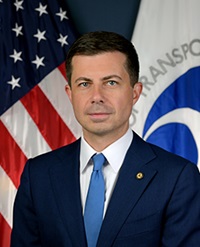Ensuring That America’s Aviation Future Is Even Brighter Than Its Past
By Pete Buttigieg, Secretary, U.S. Department of Transportation
 On January 5, a piece of a B-737 MAX 9 violently blew off the airplane as it was climbing over Portland, Ore., opening a large hole on the side of the aircraft and terrifying passengers. Thankfully, no lives were lost, in large part to the pilots and crew who were able to remain calm and execute a successful emergency landing. But the accident has, rightly, raised important concerns about aviation safety—something too often taken for granted in the United States. It demonstrated, once again, the central importance of professional and well-trained pilots.
On January 5, a piece of a B-737 MAX 9 violently blew off the airplane as it was climbing over Portland, Ore., opening a large hole on the side of the aircraft and terrifying passengers. Thankfully, no lives were lost, in large part to the pilots and crew who were able to remain calm and execute a successful emergency landing. But the accident has, rightly, raised important concerns about aviation safety—something too often taken for granted in the United States. It demonstrated, once again, the central importance of professional and well-trained pilots.
The U.S. hasn’t seen a fatal commercial airplane crash in 14 years. That’s not the result of luck—it’s a testament to the efforts of countless safety advocates, air traffic controllers, engineers, designers, policy makers, airline crews, flight attendants, and, of course, pilots. Thanks to their work, the safest mode of transportation in America is, astonishingly, one that involves being propelled by flammable liquids through the sky in a metal tube miles above the ground at nearly the speed of sound.
When an airplane is in the air, the life of every soul aboard is in the pilots’ hands. Pilots make the final decisions. And they ought to have the tools, resources, and support they need to do those jobs as effectively as possible—because so much depends on it.
In other words, to ensure the continued safety of the traveling public, we must support our pilots. And that’s what President Biden and this Department of Transportation (DOT) are doing.
In the past few years, American aviation has faced arguably its greatest challenges since 9/11. Just four years ago, when the pandemic hit, many wondered if the industry as we know it would even survive. But thanks to the CARES Act and President Biden’s American Rescue Plan, aviation not only survived, but rebounded faster than most thought possible.
When that quick rebound brought new challenges, the DOT took action. Everyone has seen the disturbing videos of unruly and even violent behavior from airline passengers—behavior that hit new highs in recent years. That behavior puts everyone on the airplane at risk, and we don’t tolerate it. In 2021, we implemented a zero-tolerance policy for unruly passengers. In 2022, we made it permanent. And since then, we’ve fined violators up to tens of thousands of dollars and referred cases to the FBI for criminal review.
These incidents range from harassment of fellow passengers to assaults on flight attendants—and even attempts to breach the flight deck. Since 9/11, ALPA has advocated for a secondary barrier on commercial aircraft to prevent hostile passengers from reaching the flight deck even when the cockpit door is open. After two frustrating decades of pushing across multiple administrations, President Biden finally delivered on that change this past June when the FAA officially announced that it would now require a secondary barrier for all new commercial airplanes.
It’s not just pilots’ physical safety—we can and must also prioritize their mental health. Safety experts from across the aviation sector—and indeed, across every sector—agree that we need to do more on this front, including destigmatizing conversations around mental health, demystifying the journey from diagnosis to treatment to recovery, and breaking down the barriers that discourage people from seeking help. To that end, we recently launched our new Mental Health and Aviation Medical Clearances Rulemaking Committee (ARC). The ARC will bring together medical and aviation experts to help us identify the best ways to make it easier for pilots to access mental health care and report when they need help.
Anyone in any job should be able to report concerns without fear—and that’s especially true for pilots whose jobs are so crucial. We’ve already seen an increase in this kind of confidential, nonpunitive reporting in recent years, which is a good sign. If we want flying to stay the safest mode of transportation in the country, we need people to keep reporting their concerns so we can learn from them and get better with each new generation of pilots.
And that next generation will be here soon. Around this time last year, I had a chance to congratulate the first-ever graduating class of United Aviate Academy, which largely hailed from backgrounds that have historically been underrepresented on the flight deck. And hundreds more students have already enrolled. Those students shared stories of their journeys with me. Some had dreamed of being pilots since they were children; others had never even imagined that they could pursue a career in aviation but made the leap when they heard about the opportunity.
By the time this next crop of students becomes fully qualified pilots, the profession will likely be even more in demand, and I hope and believe that it will be even more rewarding than it is today.
We live in the country that ushered in the modern aviation age. And we owe it to the pilots who led the way to ensure that America’s aviation future is even brighter than its past.

